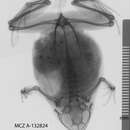Description
provided by AmphibiaWeb articles
Part of the specimens previously belonging to Sphenophryne macrorhyncha (Zweifel, 1956) now belong to this species Austrochaperina derongo. This is a moderate sized species with a maximum SVL of females being 42 mm and males 37 mm. Head is narrower than the body. Snout is subacute in dorsal view and strongly projecting when viewed laterally. The canthus rostralis is rounded and the loreal region is nearly vertical while shallowly concave. Eyes are small, laterally placed, and have an interorbital space more than twice the width of the upper eyelid. Relative finger lengths are as follows: 3>4>2>1, with the first digit reaching to the anterior edge of subarticular elevation of the second. The relative toe lengths are as follows: 4>3>5>2>1; the first toe is short and reaches the base of subarticular of the second. All toes have a terminal disc. Body is smooth. In preservative, the coloration is a gray-brown with many darker speckles and a pale band extending a short distance behind the eye on the dorsal surface of the head. Lateral and groin region are also a pale ground color. Ventral skin is pale and unmarked. Soles are brown with pale irregular markings. Most males have the tip of the snout much paler than the rest of the head (some females have this as well).
- Paijmans, K. (1975). ''Explanatory notes to the vegetation map of Papua New Guinea.'' CSIRO Land Res. Ser., 35, 1-25.
- Zweifel, R.G. (1956). ''Results from the Archbold Expeditions. Microhylid frogs from New Guinea, with descriptions of new species.'' American Museum Novitates, 72, 1-49.
Distribution and Habitat
provided by AmphibiaWeb articles
Males call from areas adjacent to water. According to Paijmans (1975), the habitat in which this species has been collected are considered to be “medium crowned lowland hill forest.” Austrochaperina derongo have been found from low to moderate elevations along the southern flank of the central dividing range east of Irian Jaya/Papua New Guinea border.
Life History, Abundance, Activity, and Special Behaviors
provided by AmphibiaWeb articles
Call: a series of brief, harsh, pulsed notes (Zweifel, 2000). “A typical note begins with three brief pulses followed by several longer, louder ones gradually diminishing in duration and intensity” (Zweifel, 2000).
Copiula derongo: Brief Summary
provided by wikipedia EN
Copiula derongo is a species of frog in the family Microhylidae. It is endemic to New Guinea and found in both Indonesia and Papua New Guinea. The specific name derongo refers to its type locality, the village of Derongo in the Western Province (Papua New Guinea). Based on molecular evidence, it was transferred from Austrochaperina to Copiula in 2016.
- license
- cc-by-sa-3.0
- copyright
- Wikipedia authors and editors

